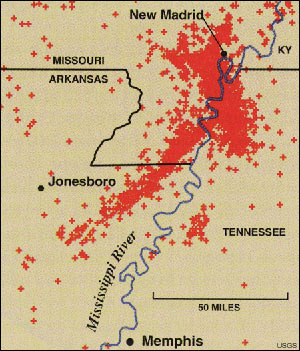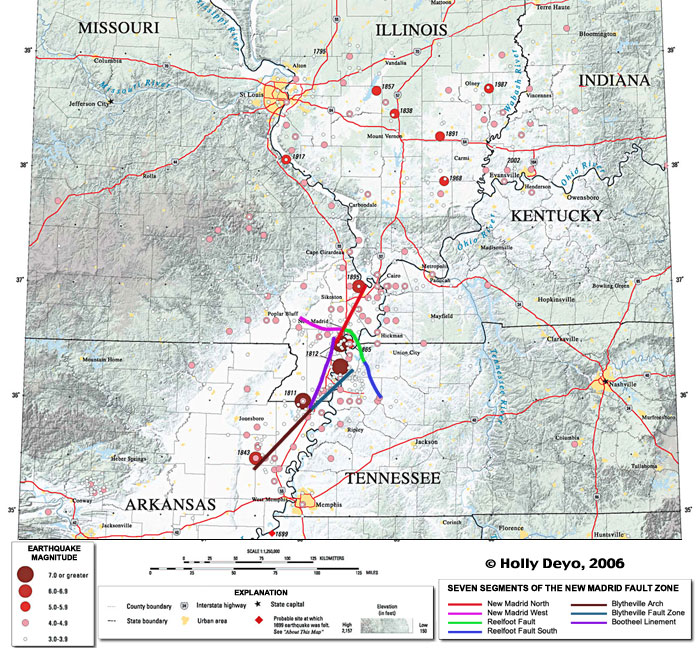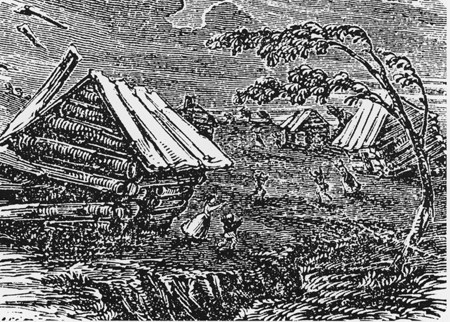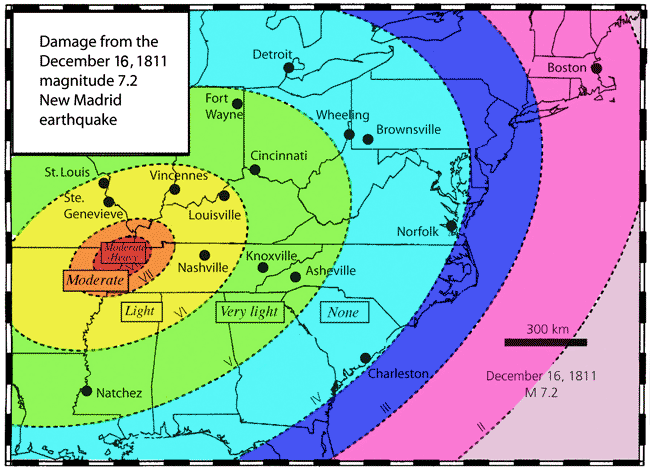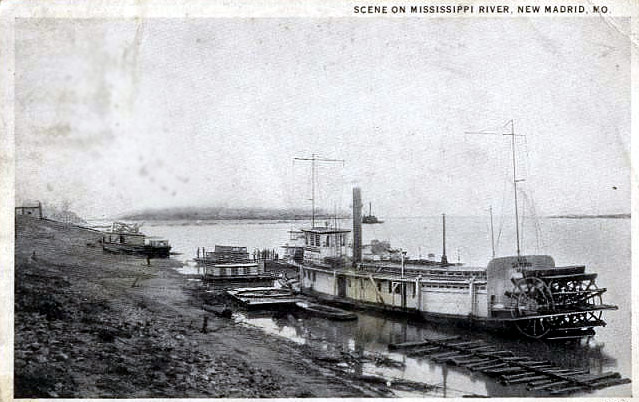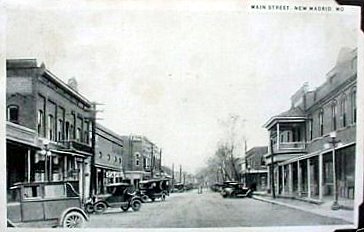The New Madrid Earthquake of 1811-1812 was actually a series of over 2000 shocks in five months. Some seismologists estimate that five of the New Madrid shocks were 8.0 or more in magnitude. Eighteen of these rang church bells on the Eastern seaboard. The very land itself was destroyed in the Missouri Bootheel, making it unfit even for farmers for many years. It may have been the largest burst of seismic energy east of the Rocky Mountains in the history of the United States and some estimates place it at several times larger than the San Francisco quake of 1906. [5]
Most accounts place the three strongest temblors of the New Madrid series of earthquakes at 7.7, 7.7 and 7.5 respectively. If one was to compare the New Madrid earthquakes to the strongest seismic events in all 50 states, the New Madrid earthquakes ranked at 18, 19, and 20 out of the 20 strongest earthquakes to strike the United States. To give the reader an idea of just how powerful the New Madrid events were, the San Francisco earthquake of 1906 measured in at a magnitude 7.8. The majority of this nation’s most powerful earthquakes have taken place in the sparsely populated areas of Alaska. 12 out of 20 of this nation’s most powerful seismic events occurred in Alaska. In comparing the New Madrid event to just earthquakes to occur in the lower 48 states, the New Madrid event would ranks as the fifth, sixth and seventh, out of the top 15 most powerful seismic events to hit the lower 48 states. [1]
[6]
Yet, other sources list the magnitude of the February 7, 1812 New Madrid quake as high as 8.8, which would place that single seismic event as the second most powerful; and if more conservative estimates of 7.7 still possibly the third most powerful seismic event to ever strike in any of the 50 states, and the second most powerful earthquake event to hit in just the lower 48 states. [1]
The primary reason why the loss of life and property was so low in regards to the series of New Madrid earthquakes was due to the simple fact that the New Madrid Territory was sparsely settled and populated at the time. When comparing the magnitude and damage of the New Madrid earthquake with that of the San Francisco earthquake, the two earthquakes were similar in magnitude being separated by just one tenth of a degree in magnitude, as each whole number increase in magnitude represents a tenfold increase in measured amplitude. [2][3]
The destruction caused by the San Francisco earthquake event was severe due to the population center of San Francisco being situated almost on top of the epicenter of the earthquake, which was just two miles off shore. In geologic terms, the epicenter of the San Francisco earthquake can be considered a direct hit on San Francisco. [4]
Panoramic View of San Francisco after the 1906 earthquake [7]
At the time of the San Francisco earthquake, 3000 deaths were reported. Additionally, hundreds of casualties in Chinatown went ignored and unrecorded. Most of the deaths occurred in San Francisco itself, but 189 were reported elsewhere in the Bay Area. In nearby cities, such as Santa Rosa and San Jose severe damage occurred. In Monterey County, the earthquake permanently shifted the course of the Salinas River near its mouth. Where previously the river emptied into Monterey Bay between Moss Landing and Watsonville, it was diverted 6 miles south to a new outlet just north of Marina.
Between 227,000 and 300,000 people were left homeless out of a population of about 410,000; half of the people who evacuated (evacuees) fled across the bay to Oakland and Berkeley. Newspapers at the time described Golden Gate Park, the Presidio, the Panhandle and the beaches between Ingleside and North Beach as being covered with makeshift tents. More than two years later in 1908, many of these refugee camps were still in full operation. [4] Had the New Madrid territory resembled San Francisco at the time of the New Madrid earthquake, the loss of life and property would have been much higher.
The New Madrid fault system extends 120 miles southward from the area of Charleston, Missouri, and Cairo, Illinois, through New Madrid and Caruthersville, following Interstate 55 to Blytheville and on down to Marked Tree, Arkansas. It crosses five state lines and cuts across the Mississippi River in three places and the Ohio River in two places.
[6]
The fault is active, averaging more than 200 measured events per year (1.0 or more on the Richter scale), about 20 per month. Tremors large enough to be felt (2.5 - 3.0 on the Richter scale) are noted annually. Every 18 months the fault releases a shock of 4.0 or more, capable of local minor damage. The most recent registering 4.3 along the New Madrid Fault on Thanksgiving evening, 1996, which was felt by citizens in the states of Missouri, Arkansas, Tennessee and Kentucky, Illinois and Mississippi. Magnitudes of 5.0 or greater occurring about once per decade, can do significant damage, and be felt in several states.
The highest earthquake risk in the United States outside the West Coast is along the New Madrid fault. Damaging tremors are not as frequent as in California, but when they occur, the destruction covers over more than 20 times the area because of underlying geology.
A major earthquake in this area, 7.5 or greater, happens every 200- 300 years (the last one in 1812). There is a 25% chance by 2040. A New Madrid Fault rupture this size would be felt throughout half the United States and damage 20 states or more. Missouri alone could anticipate losses of at least $6 billion from such an event. [5]
[6]
11 million people live in the New Madrid Seismic Zone. Geologists the earthquake center at the University of Memphis, have predicted that a magnitude 8 earthquake could occur in the New Madrid zone every 550-1,000 years. Because of shock effects, such a quake could cause tens of billions of dollars worth of damage from Mississippi to Michigan, leveling Memphis and seriously damaging St. Louis. A magnitude 7 earthquake could occur within 50-100 years, and one registering magnitude 6 could occur at any time, according forecasts. [6] Tens of thousands could be killed in such a disaster. Yet, preparedness for the ‘Big One‘ in this area is low. A large and devastating earthquake has never hit in living memory. The people living in the former New Madrid territories and the surrounding areas have grown complacent, which reminds us of the old saying; out of sight, out of mind.
[1] http://earthquake.usgs.gov/earthquakes/states/10_largest_us.php
[2] http://earthquake.usgs.gov/earthquakes/states/events/1906_04_18.php
[3] http://en.wikipedia.org/wiki/Richter_magnitude_scale
[4] http://en.wikipedia.org/wiki/1906_San_Francisco_earthquake
[5] http://www.scchealth.org/docs/ems/docs/prepare/newmadrid.html
[6] http://www.greatdreams.com/madrid.htm
[7] http://en.wikipedia.org/wiki/File:San_Francisco_1906_earthquake_Panoramic_View.jpg
